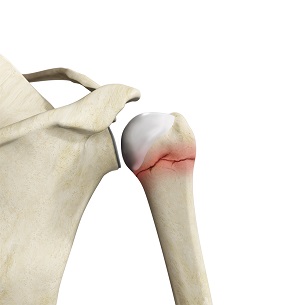
Anatomy of the Humerus
The humerus is the bone that forms the upper arm. It articulates with the glenoid cavity of the scapula (shoulder blade) to form the shoulder joint and with the lower arm bones – the ulna and radius – to form the elbow joint. The proximal humerus is the upper end of the arm bone that forms the shoulder joint. The humerus is broadly divided into the head, neck and shaft region. Just below the head are two processes called the greater and lesser tubercles, which form the sites of attachment for the rotator cuff muscles.
Causes of Proximal Humerus Fractures
Fractures of the proximal humerus are common in elderly individuals suffering from osteoporosis. In younger individuals, a severe trauma such as a fall from a height on an outstretched hand or motor vehicle accident can cause these fractures.
Types of Proximal Humerus Fractures
Proximal humerus fractures can be categorized into 4 groups:
Humeral head fractures: Humeral head fractures very often occur in elderly individuals and chances are more in those with osteoporotic bone. While mild trauma can break humeral head in the elderly, a more significant trauma results in its fracture in the young.
Surgical neck fractures: Fractures of the surgical neck are most common in osteoporotic bone. These fractures also damage the axillary nerve that carries sensory information from the shoulder.
Greater tuberosity fractures: Greater tuberosity fractures are less common and are seen in cases of shoulder dislocations and in those with osteoporosis. A fragment of the greater tuberosity is pulled off when the cuff muscle contracts or the anterior shoulder dislocates. Direct impact on the shoulder causes the tuberosity bone to break into multiple fragments. Partial rotator cuff tears often accompany non-displaced fractures and these fractures can be diagnosed using MRI or diagnostic arthroscopy.
Lesser tuberosity fractures: These fractures are often caused by posterior shoulder dislocations or traumatic muscle contractions by electrical shock or convulsions. If left untreated, these fractures can cause subscapularis muscle (stabilizer and mobilizer muscle) deficiency and require a major muscle transfer procedure.
In addition to the above, other types of proximal humerus fractures are two, three and four-part fractures. A fracture causes multiple fragmentations of the proximal humerus.
Symptoms of Proximal Humerus Fractures
You may experience severe pain, swelling and restricted motion of the shoulder.
Diagnosis of Proximal Humerus Fractures
A proximal humerus fracture is diagnosed by a physical examination, X-ray of the affected area and/or computerized tomography (CT) scan.
Treatments for Proximal Humerus Fractures
Most proximal humerus fractures are minimally displaced and can be treated with conservative approaches such as the use of a sling to immobilize your arm and early physical therapy to improve the functional outcome. Surgery may be necessary for displaced fractures. The multiple fragments are fixed with plates, screws or pins, and in severe cases, shoulder replacement surgery is performed.




